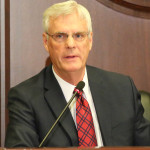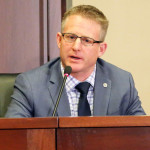Gov. Butch Otter on Thursday promised to use Monday’s State of the State address to propose initiatives designed to improve Idaho’ high school graduation rates.

For years, Otter and members of the State Board of Education have promoted their flagship higher education goal of seeing 60 percent of the Gem State’s young adults hold a college degree or certificate by 2020.
But a new report released last month by the U.S. Department of Education showed that Idaho’s high school graduation rate ranked 41st in the country and was lower than state officials thought.
Both the U.S. Department of Education and the State Department of Education reported that Idaho’s high school graduation rate for 2013-14 was 77.3 percent.
“I was surprised,” Otter said. “In the past, it seems to me whenever we look at those national comparisons Idaho had always been fairly high — 80-some percent, 88 percent at one time. I was surprised to see it drop that far that fast.”
On Monday, Otter will deliver his annual State of the State address and budget proposal at the Statehouse. The speech serves as the traditional opening of a new legislative session, and generally sets an early tone for policy and budget discussions.
During a one-hour briefing with reporters Thursday, the governor was tight-lipped about how his plans to improve high school graduation rates will factor into his speech or his 2016-17 budget proposal.
“I can’t divulge a lot of what will be in my State of the State,” Otter said. “(But) we’ve got initiatives in there.”
Otter did emphasize that he is committed to improving high school graduation rates. Like Superintendent of Public Instruction Sherri Ybarra, Otter mentioned that he would like to see graduation rates reach 100 percent.
Later Thursday morning, some legislative leaders also expressed surprise with the report.

Senate President Pro Tem Brent Hill, R-Rexburg, said Idaho leaders for years had operated under the assumption that Idaho’s high school graduation rates were very high while its college go-on and college completion rates were low.
“I think this caught us a little off guard,” Hill said.
Like Otter, House Speaker Scott Bedke, R-Oakley, questioned the accuracy of the new calculations and wondered why Idaho’s rate dropped.
“That kind of irritated me when it came out,” Bedke said.
The new federal formula involves tracking students beginning in their ninth grade year and calculating the graduation rate based on how many graduate high school within four years.
Previously, Idaho leaders tracked students in their senior year and calculated the rate based on how many graduated that same year.
Nevertheless, Bedke said that if Idaho’s numbers are accurate they are “unacceptable” and “should trigger a state response.”
Hill told reporters “I don’t have any reason to doubt (the accuracy of the statistics) except that they are different than what I’ve been told all these years.”

House Assistant Minority Leader Mat Erpelding, D-Boise, speculated that some of the reason for the low graduation and go-on rates may be cultural and suggested leaders need to do a better job of promoting education attainment to rural and urban students alike.
Erpelding also said Idaho has an “underlying, endemic problem in our education system that has to do with how we are currently funding” schools.
Looking ahead, Otter said he is “hopeful for a short session” and has told Bedke he would like to see lawmakers adjourn for the year in 65 days — on or about St. Patrick’s Day. Last year, lawmakers adjourned for the year after 89 days — the longest session since 2009. Otter also pulled lawmakers back to Boise last May for a one-day special session.
Check back with Idaho Education News on Monday — and follow our live Twitter feed — for full coverage of Otter’s State of the State address.
